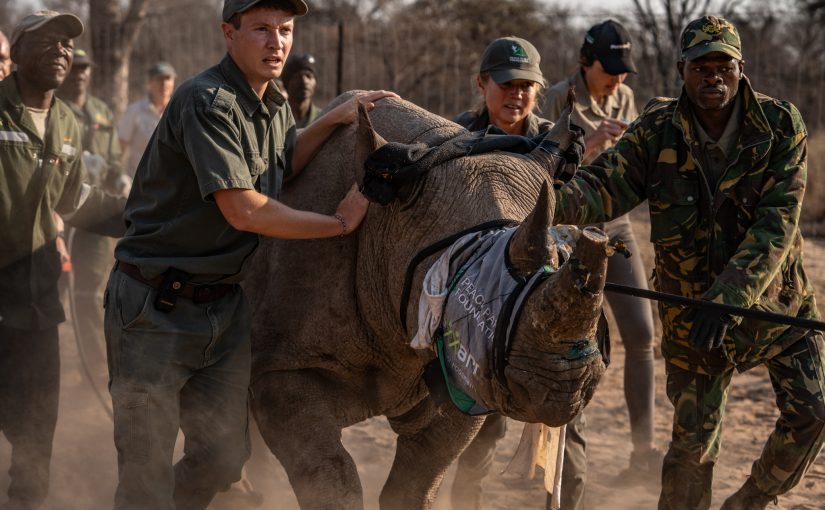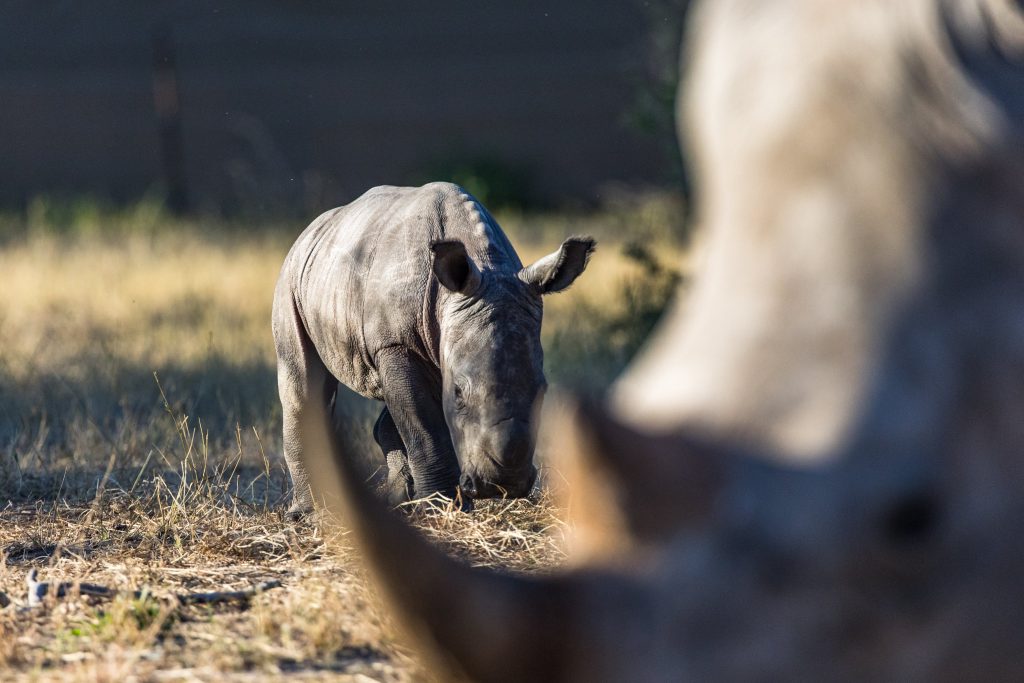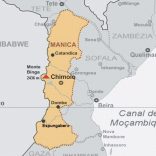Mozambique cyclone cluster raises fears of new norm
Mozambique Government, Peace Parks Foundation and partners secure massive success for rhino survival

All photos: Peace Parks Foundation
- Third group of rhino from South Africa to Mozambique establishes viable population in Zinave National Park.
In an extraordinary achievement for cross-border conservation and community livelihoods, an additional 10 rhinos have been successfully transported from South Africa to Zinave National Park, Mozambique. This marks a significant milestone in the park’s ongoing restoration efforts.
The ambitious operation, the third following last year’s pioneering cross-border rhino translocations, is the result of a collaborative partnership between Mozambique’s National Administration for Conservation Areas (ANAC), Peace Parks Foundation, and Exxaro Resources, with the support of the Government of South Africa. Exxaro generously donated the rhinos and have made a substantial contribution to the park’s operational costs, with additional funding provided by Anglo American, the De Beers Group, Geos Foundation, German Postcode Lottery, the MAVA Foundation and private donors.
This latest translocation includes 5 black (classified as Critically Endangered by the IUCN Red List of Species) and 5 white rhino (classified as Near Threatened by the IUCN Red List of Species) from Manketti Game Reserve in South Africa to Zinave, and forms part of a larger landmark effort to restore numbers of both species in the park to establish a founder population of African rhino in Mozambique.

Established in 1973, Zinave National Park holds the distinction of being Mozambique’s first Big Five national park and plays a crucial role within the Great Limpopo transboundary landscape. ANAC and Peace Parks Foundation signed a 20-year agreement in 2015 to restore, develop, and manage Zinave, setting the stage for its remarkable restoration and leading to immeasurable biodiversity benefits. The long-term objective is to restore a large landscape of over 100,000 square kilometres, spanning the international borders of three countries.
Equally significant is the empowerment of Zinave’s communities, enabling them to participate in the initiative and share in its economic returns, fostering equitable and sustainable conservation.
“Mozambique proudly holds the global stage with its first rhino reintroduction into Zinave National Park, underscoring our commitment to biodiversity conservation and community upliftment,” said The Hon Ms Ivete Maibaze, Minister of Land and the Environment, Mozambique.
“Together with Peace Parks, we’re realising the untapped potential of responsible tourism, heralding a new era of celebrated impact for both our precious landscapes and our people.”
Two previous successful rewilding operations saw the relocation of 20 white and seven black rhinos from Exxaro’s private reserve in South Africa. These pioneering translocations, reintroducing the first 27 African rhino to populate the park in more than four decades, still remain the longest distance by road that rhino have ever been relocated from one destination to another. The addition of five more individuals from each species further strengthens the foundations of Mozambique’s first Big Five pillars of biodiversity and tourism in Zinave.
The three key partners, supported by specialist teams, dedicated years to meticulous planning, culminating in a three-day road journey to transport the rhinos under the supervision of veterinary and security experts.
Professional care will continue as the rhinos acclimate to their new environment, ensuring their protection through the deployment of Quick Response Force rangers and state-of-the-art conservation technology, creating a long-term safeguard for the entire national park.
“As a responsible mining company, Exxaro embraces Environmental, Social, and Governance (ESG) principles through our momentous decision to donate rhinos to Zinave,” said Dr Nombasa Tsengwa CEO of Exxaro Resources. “This initiative reflects our commitment not only to mining, but also to fostering sustainable ecosystems and thriving communities.

This landmark partnership with Peace Parks Foundation serves as a model for ESG in action, promoting biodiversity while underscoring the integral role every stakeholder plays in the future of these species.”
The impressive demonstration of functional transboundary landscapes through political will and leadership of the Governments of Mozambique, South Africa and Zimbabwe, has paved the way for effective implementation, capacity-building and expertise, enabling conservation and enterprise at an unprecedented scale.
Rewilding initiatives and enhanced landscape connectivity have allowed numerous species to roam across borders, benefiting from increased range and population strength, thereby creating wildlife economies and community benefit-sharing opportunities.
“As Peace Parks celebrates a quarter of a century of existence and Zinave its golden jubilee, we’re marking a significant milestone with the successful rewilding of rhinos as a flagship species” said Werner Myburgh, CEO of Peace Parks Foundation. “This accomplishment signals that through public private partnerships, the future of protected areas in Africa is very bright”.
In addition to actively introducing species such as elephant, buffalo, and leopard, the natural return of lion after decades demonstrates the park’s intrinsic rewilding success.
Together with the reintroduction of rhino, this achievement re-establishes the Big Five, a celebrated indicator of ecosystem health, balance, and complexity, elevating Zinave as a world-class tourism destination.
A huge step in Mozambique’s mighty African Rhino Revival: a 5 + 5 force of nature has just arrived in Zinave National Park! 🦏🦏👏#NatureWithoutBorders
Read more here: https://t.co/gtIyvKz6bN pic.twitter.com/1CoE5sCG36
— PeaceParksFoundation (@Peace_Parks) September 10, 2023
About
Rewilding in the Great Limpopo Transfrontier Conservation Area (GLTFCA) and Zinave National Park:
Peace Parks facilitates and funds the translocation of animals from protected areas where effective conservation management has seen wildlife numbers bloom to surplus status, or where they are at risk, to parks in Great Limpopo that have been left devoid of wildlife following years of conflict and persecution.
To date more than 7,000 animals have been moved from eSwatini, South Africa and Mozambique to Zinave and Limpopo national parks. The reintroduction of wildlife also assists with the revitalisation of historic ecological linkages and migration routes across man-made borders, with planning, development and implementation of wildlife dispersal areas assisted by Peace Parks. Zinave, along with Limpopo and Banhine national parks, is part of the larger landscape linking various Protected Areas that ensure functional and healthy ecosystems.
National Administration of Conservation Areas
Established in 2011, the National Administration for Conservation Areas (ANAC) of Mozambique is a government institution responsible for the conservation of biodiversity and the sustainable development of ecotourism in Mozambique. Its main functions involve the planning, coordination and execution of activities in conservation areas, in partnership with national and international organizations and local communities. Mozambique’s conservation areas occupy approximately 25% of the country, including parks, reserves, environmental protection areas, controlled hunting areas, community conservation areas and game farms.
www.anac.gov.mz
Ivan Mauro Zacarias, Communication Manager, [email protected]
Peace Parks Foundation
Peace Parks was established 25 years ago by Dr Anton Rupert, Prince Bernhard of the Netherlands and President Nelson Mandela to facilitate the establishment and development of transboundary landscapes in Africa. To date, ten transboundary landscapes have been formally recognised throughout southern Africa, spanning over one million square kilometres and ten countries, which makes this arguably one of the largest terrestrial conservation movements in the world. In Mozambique, Peace Parks is the long-term co-management partner in the rehabilitation and management of four protected areas measuring over 27,000 square kilometres. Zinave National Park is one of three parks being developed with support from Peace Parks as an integral component of the Great Limpopo transboundary landscape with South Africa and Zimbabwe.
www.peaceparks.org
Francois Rogers, [email protected]
Exxaro Resources
Established in 2006, Exxaro Resources has grown to become one of the largest black-empowered diversified mining companies in South Africa. Exxaro has an asset portfolio, which includes coal operations and investments in iron ore, residual pigment manufacturing and renewable (wind and solar) energy (Cennergi). The organisation prides itself on being more than just a mining business and strongly believes that empowering local communities and making a positive impact on the world is central to its purpose. The company assumes and actively practices a balanced approach for sustainable growth and impact, to ensure that a future is secured for every one of its stakeholders. Exxaro’s purpose to Power better Lives in Africa and beyond will be achieved by responsibly investing in resources that will improve and sustain life on the continent. In the last decade, Exxaro has established itself as an organisation that is respected by its peers for its innovation, ethics and integrity, and has been recognised as a leading performer in the FTSE Russel ESG Index.
www.exxaro.com
Tsabeng Nthite, Stakeholder Communications Manager, [email protected]
In a remarkable feat for cross-border conservation and local livelihoods, we are relieved and excited to announce the successful transfer of an additional 10 rhinos from South Africa to Zinave National Park! #Naturewithoutborders
Read more here: https://t.co/UVKJ6yxJrk pic.twitter.com/AAIh7zyDkR
— PeaceParksFoundation (@Peace_Parks) September 10, 2023












Leave a Reply
Be the First to Comment!
You must be logged in to post a comment.
You must be logged in to post a comment.